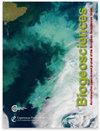Impact of seawater sulfate concentration on sulfur concentration and isotopic composition in calcite of two cultured benthic foraminifera
IF 3.9
2区 地球科学
Q1 ECOLOGY
引用次数: 0
Abstract
Abstract. Marine sediments can be used to reconstruct the evolution of seawater [SO42-] and δ34S over time, two key parameters that contribute to refine our understanding of the sulfur cycle and thus of Earth's redox state. δ34S evolution can be measured from carbonates, barites and sulfate evaporites. [SO42-] variations can be reconstructed using fluid inclusions in halites, a method that only allows a low-resolution record. Reconstruction of the past sulfur cycle could be improved if carbonates allowed the tracking of both seawater δ34S and [SO42-] variations in a sole, continuous sedimentary repository. However, most primary carbonates formed in the ocean are biogenic, and organisms tend to overprint the geochemical signatures of their carbonates through a combination of processes often collectively referred to as vital effects. Hence, calibrations are needed to allow seawater δ34S and [SO42-] reconstructions based on biogenic carbonates. Because foraminifera are important marine calcifiers, we opted to focus on calcite synthesized by individuals of rosalinid benthic foraminifera cultured in the laboratory under controlled conditions, with varying seawater [SO42-] (ranging from 0 to 180 mM). Our experimental design allowed us to obtain foraminiferal asexual reproduction over several generations. We measured bulk carbonate-associated sulfate (CAS) content and sulfur isotopic composition (δ34SCAS) on samples of tens to hundreds of specimens from a selection of culture media, where [SO42-] varied from 5 to 60 mM. Increasing or decreasing [SO42-] with respect to modern-day seawater concentration (28 mM) impacted foraminiferal population size dynamics and the total amount of bioprecipitated carbonate. Foraminiferal CAS concentration increased proportionally with [SO42-] concentration from 5 mM up to 28 mM and then showed a plateau from 28 to 60 mM. The existence of a threshold at 28 mM is interpreted as the result of a control on the precipitation fluid chemistry that foraminifera exert on the carbonate precipitation loci. However, at high seawater sulfate concentrations (> 40 mM) the formation of sulfate complexes with other cations may partially contribute to the non-linearity of the CAS concentration in foraminiferal tests at high increases in [SO42-]. Yet, despite the significant effect of seawater [SO42-] on foraminiferal reproduction and on CAS incorporation, the isotopic fractionation between CAS and seawater remains stable through varying seawater [SO42-]. Altogether, these results illustrate that CAS in biogenic calcite could constitute a good proxy for both seawater [SO42-] and δ34S and suggests that sulfate likely plays a role in foraminiferal biomineralization and biological activity.海水硫酸盐浓度对两种养殖底栖有孔虫方解石中硫浓度和同位素组成的影响
摘要。海洋沉积物可用于重建海水[SO42-]和δ34S随时间的演变过程,这两个关键参数有助于完善我们对硫循环的认识,进而了解地球的氧化还原状态。δ34S的演变可以通过碳酸盐、重晶石和硫酸盐蒸发岩来测量。[SO42-] 的变化可以利用卤石中的流体包裹体来重建,但这种方法只能获得低分辨率的记录。如果碳酸盐能够在一个唯一的、连续的沉积库中同时跟踪海水δ34S和[SO42-]的变化,那么对过去硫循环的重建就会得到改善。然而,海洋中形成的大多数原生碳酸盐都是生物源性的,而生物往往会通过一系列通常统称为生命效应的过程叠加其碳酸盐的地球化学特征。因此,需要进行校准,以便根据生物碳酸盐重建海水 δ34S 和 [SO42-]。由于有孔虫是重要的海洋钙化器,我们选择在实验室中,在不同的海水[SO42-](从 0 到 180 mM)条件下,重点研究有孔虫个体合成的方解石。我们的实验设计使我们能够获得有孔虫几代的无性繁殖。在[SO42-]从5毫摩尔到60毫摩尔不等的培养基中,我们测量了几十个到几百个标本的大量碳酸盐相关硫酸盐(CAS)含量和硫同位素组成(δ34SCAS)。与现代海水浓度(28 mM)相比,[SO42-]的增减会影响有孔虫的种群数量动态和生物沉淀碳酸盐的总量。有孔虫CAS的浓度随[SO42-]浓度的增加而增加,从5 mM到28 mM,然后在28 mM到60 mM之间出现一个平稳期。有孔虫在 28 毫摩尔处的阈值被解释为有孔虫对碳酸盐沉淀位点的沉淀液化学性质进行控制的结果。然而,在海水硫酸盐浓度较高(> 40 mM)的情况下,硫酸盐与其它阳离子形成的络合物可能会部分导致有孔虫试验中 CAS 浓度在[SO42-]高度增加时的非线性。然而,尽管海水中的[SO42-]对有孔虫的繁殖和CAS的加入有显著影响,但CAS与海水之间的同位素分馏在不同的海水[SO42-]条件下保持稳定。总之,这些结果表明,生物方解石中的 CAS 可以很好地替代海水[SO42-]和δ34S,并表明硫酸盐可能在有孔虫的生物矿化和生物活动中发挥作用。
本文章由计算机程序翻译,如有差异,请以英文原文为准。
求助全文
约1分钟内获得全文
求助全文
来源期刊

Biogeosciences
环境科学-地球科学综合
CiteScore
8.60
自引率
8.20%
发文量
258
审稿时长
4.2 months
期刊介绍:
Biogeosciences (BG) is an international scientific journal dedicated to the publication and discussion of research articles, short communications and review papers on all aspects of the interactions between the biological, chemical and physical processes in terrestrial or extraterrestrial life with the geosphere, hydrosphere and atmosphere. The objective of the journal is to cut across the boundaries of established sciences and achieve an interdisciplinary view of these interactions. Experimental, conceptual and modelling approaches are welcome.
 求助内容:
求助内容: 应助结果提醒方式:
应助结果提醒方式:


